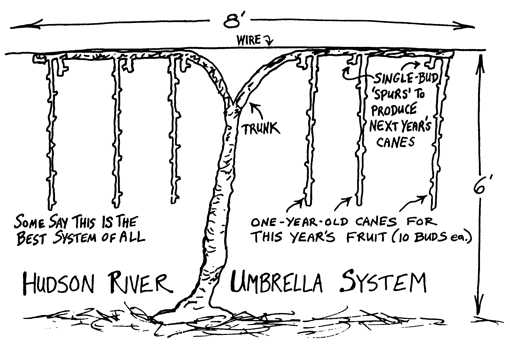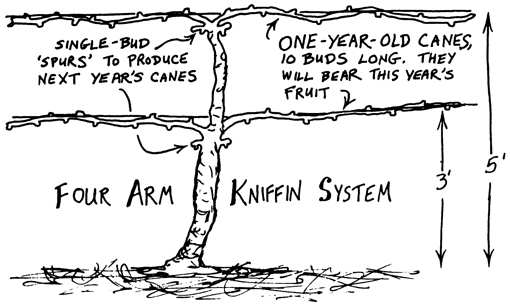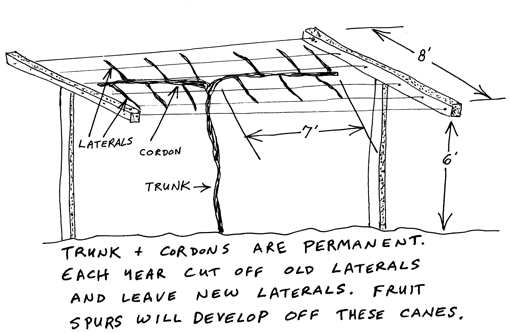Pruning Trees and Perennials
You can find high-quality pruning tools made by Felco, Silky, and Wheeler in our selection of pruning tools in the Organic Growers Supply catalog.
Initial Pruning at Planting TimePruning Fruit Trees
Highbush Blueberries
Grapes
Hardy Kiwi
Conifers
Roses
Lilacs
Ornamental Shrubs, Trees and Berries
Clematis
Initial Pruning at Planting Time
For most trees and shrubs: Prune dead or injured branches or
roots. Further pruning of most trees is not necessary at planting time.
Nut trees: Do not prune tops, or prune or bend tap
roots.
Conifers: Prune off 1/3 of the roots.
Roses: Prune roses back to 3 canes, 2–5" tall.
Pruning Fruit Trees
Avoid pruning young trees except to establish a basic shape, as it delays bearing. On apple and pear trees, leave the central leader alone and let it grow. It’s okay to cut off extra trunks and large branches. It’s okay to prune any branches that were broken during shipping. Always remove suckers or root shoots from fruit trees. On peaches and plums, the trees may want to develop 2–4 leaders, or an open-vase shape. Always prune just above a good strong bud that faces a direction you’d like your plant to grow.
Sometimes we need to prune a central leader in order to fit a tree into a shipping box; don’t worry—a new leader will grow from the topmost bud.
Pruning your new standard or semi-dwarf apple tree
Standard and semi-dwarf (Bud 118 and M111) apple trees will almost always benefit from pruning when first planted, to establish the long-term basic shape for the tree. Then refrain from pruning until the tree begins to fruit. Every time you prune potential leaf-bearing branches from a young tree, you set it back. The tree will grow quickly and fruit sooner if you allow it to maximize photosynthesis. Once it begins to fruit, then you prune it annually.
- Year one: If the tree is a branch-less
“whip,” cut the top back to a strong bud about 3–4'
high. This will force branching at that level. This will eventually be
your first tier of branches. The lowest scaffold (branch layer) should
be very wide to collect as much sun as possible. If too low, these long
branches will rest on the ground under the weight of fruit, and the deer
will have a field day. Also, it becomes difficult to mow, mulch,
etc.
If the new tree arrives with branches, prune off all but 3–4 branches at the height you’d like for your first tier, also at about 3–4', or higher if you prefer. - Year two: Trim off root suckers or other odd branches that come up from around the base. Otherwise, leave the tree be and let it grow.
- The next few years: If something looks really crowded, broken or dead, prune it. Otherwise, leave your tree alone and let it grow. If you don’t fuss over it too much, you’ll get fruit sooner!
Once your fruit tree begins to bear you will want to prune annually. Good pruning brings sunlight to all parts of your tree. Maximum sunlight encourages more and higher-quality fruit. Sunlight also encourages fruit buds to form for next year’s crop. A well-pruned tree will produce larger fruit and will tend toward more annual bearing. Good pruning discourages fungal diseases and promotes greater spray penetration. There’s an old saying that a bird should be able to fly through your fruit tree.
Most pruning should be done in late winter or early spring. We recommend a good-quality pair of hand shears and a lightweight pruning saw. You may also wish to invest in long-handled loppers, a pole pruner or a pole saw. Keep your pruning tools sharp for smooth, clean cuts.
Any good book on growing fruit trees will have the information you need. Consult old and new books as well as orcharding articles and develop a system that works for you. Pruning is not difficult and will make a huge difference.
Back to topHighbush Blueberries
Fruit is produced on vigorous one-year shoots off healthy canes. As canes age they become twiggy and less productive. Begin pruning after three years. Head back long sprigs of new growth for a bushier plant. Cut out weak or dead canes and dead tips. Each bush should be allowed to grow 6–10 canes varying in age from 1–6 years old. Thereafter, remove dead canes and those over 6 years old and encourage new replacement canes. Bushes with regular moderate pruning produce the most berries.
Back to topGrapes
Grapes require annual pruning and a trellis or arbor, though in Italy they still sometimes grow them in maple trees. All systems for growing grapes involve removal of most growth in spring or late fall to encourage new canes, as fruit is produced on these canes. There are many systems for training grapes. Some are suited to laying down and covering tender varieties over winter. Any good book on grape growing will show you several options. We suggest the Hudson River Umbrella or the Four-arm Kniffin system (see below). The University of Maine offers a series of videos demonstrating different grape-training techniques.

Growing Grapes on an Arbor Train one or more vines onto an arbor or gazebo; we have 8 vines, spaced about 10' apart. Prune each vine back to a single trunk. Encourage several permanent arms from each trunk. Every winter remove 70–90% of the past summer’s growth. Next summer new fruiting canes will grow off the permanent arms.
Pruning Grapes in the Four-Arm Kniffin System:
- First year: After the last danger of frost has passed, cut newly planted vines back to a single stem, 6" long with two to three buds.
- Second year: Set up two wires, 3' and 5' high, stretched between posts. Cut plant back to a single stem, 6 feet long and tie it to the top wire. Leave 4–6 buds near each wire and remove others.
- Third year: Select 8 canes, 4 for each wire, and remove the rest. Tie two canes to each wire, one in each direction. Cut these 4 canes back to 10 buds each. Cut the remaining 4 canes back to 1–2 buds each.
- Later years: In the spring, remove last year’s fruiting canes. Select eight new canes. Cut 4 of them to 10 buds each, and tie them to your wires. Cut the remaining 4 back to 2 buds each. These will produce next year’s fruiting canes. Remove all other canes. The number of buds left on the fruiting canes may be adjusted to encourage more fruit (leave more buds) or larger size (leave fewer buds).
 Back to top
Back to top
Hardy Kiwi
On a trellis: Train a single trunk to the trellis wires and then train two permanent 7–10' cordons (arms) off the trunk. Each winter remove at least 70% of old growth, leaving a dozen or so one-year-old laterals. That year’s fruit will develop on fruit spurs growing off these one-year-old canes (laterals).
Summer pruning may be required to keep extremely rampant vines from choking out your farm.
On an arbor or gazebo: Once established, prune 70% of the old growth each year and leave some new canes for this year’s fruiting.
 Back to top
Back to top
Conifers
To make evergreens dense and compact, remove the central leader and the center bud on the end of each side branch.
Back to topRoses
Shrub roses and climbers will require little pruning in later years. Any pruning should wait until after the forsythia blooms. Remove dead or broken branches, and periodically cut out the oldest wood.
Back to topLilacs
If you choose to prune your lilacs, do it right after flowering. Late-season pruning removes next year’s buds. As the plant matures, prune off a quarter of the new suckers and the oldest growth (a few main stems each year). Some growers prefer to keep the plant low and bushy. Do so by “topping” it off every year: prune any upright branch back to a junction with a lower branch. Others prefer a tall tree-like form. Our friends Philippe and Danielle have let theirs soar to 8' or more, removing the lower branches and creating a magical walkway in the process. Lilacs are more than willing to cater to your own personal vision. Have fun! No need to cut off spent flowers except for appearance.
Back to topPrune Ornamental Shrubs, Trees and Berries for:
- Rejuvenation: older canes (three years and older) can be cut off at the ground line each year to encourage the growth of new canes.
- Health: remove broken, dead or diseased branches for neatness and vigor and to increase airflow and access to sunlight.
- Vitality: prune to encourage better blooms and fruit rather than heavy excessive vegetation. Many shrubs send up new vegetative growth from the terminal bud. Pruning the terminal bud redirects the plant’s energy back to some of the lateral flowering and fruiting buds.
- Containment: certain varieties sucker from the roots; remove these suckers unless you want the shrub to spread and form colonies.
- Shape: if you desire a tall tree with a high crown, prune the lateral branches from the trunk and prevent formation of low crotches. For a low stocky tree used in screens and windbreaks, cut back the top shoots to force side growth. Retain natural arching habits and prevent the shrub from becoming top-heavy by pruning branches after flowering.
Summer-Flowering Shrubs should be pruned in late winter or early spring, before the new wood begins to grow. These shrubs blossom on the new wood they produce in the spring.
Spring-Flowering Shrubs form flower buds in the summer, after they are finished blooming. Prune them immediately after their bloom is over. If you wait and prune them in the winter or following spring, you will likely remove many flowering buds.
A common error is to prune or shear shrubs straight across the top. This encourages top-growth and the lower part of the shrub becomes woody and unsightly with less foliage. Proper pruning promotes growth at the base of the shrub.
Observe your plants and see what they need. Some shrubs benefit from aggressive pruning each year and might even respond well to being cut all the way back to the ground; others will respond by delaying fruit or blossom. Some plants thrive with little or no pruning.
Overgrown shrubs with little foliage near the base may be rejuvenated by cutting canes down to the ground in early March, even though early blooms may be sacrificed that year. They will send forth new shoots in late spring and will be bushy with foliage clear to the ground. Pinch off tops when the desired height is attained. It usually takes two to three years to rejuvenate shrubs and hedges completely.
Back to topPruning Clematis: It’s not as hard as you think!
Clematis are divided into three separate pruning groups.
- Group 1: Early season ramblers. No pruning required. Remove dead tips from the stems if you wish.
- Group 2: Early to mid-season large flowered hybrids. In February or March simply remove dead tips from the stems.
- Group 3: Late season flowering species and hybrids. In February or March Prune all the stems back to 12" above ground. Make your cuts above the old leaf joints. New growth will sprout resulting in lush and vigorous foliage.
If you have a clematis that is bare at the base with a bushy clump of flowers at the top, try pruning it according to the Group 3 method. Your plant will develop foliage from top to bottom and the flowers will spread themselves out more evenly.
Back to top